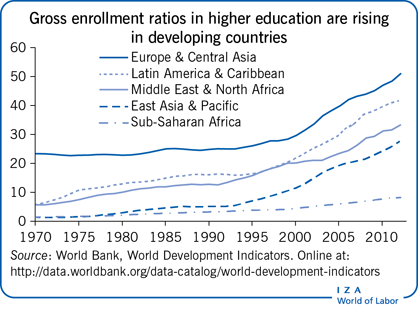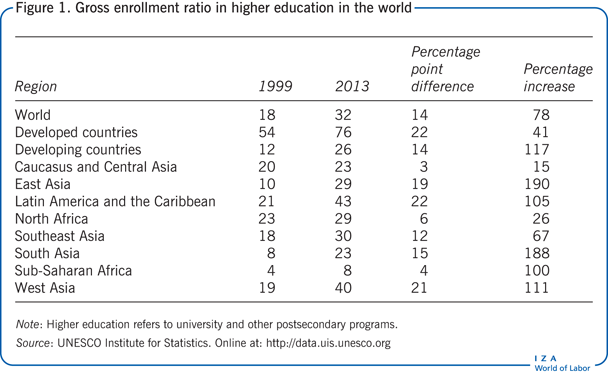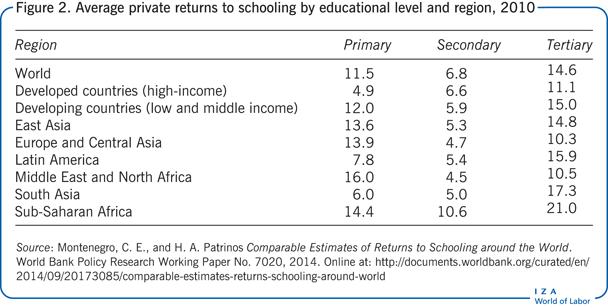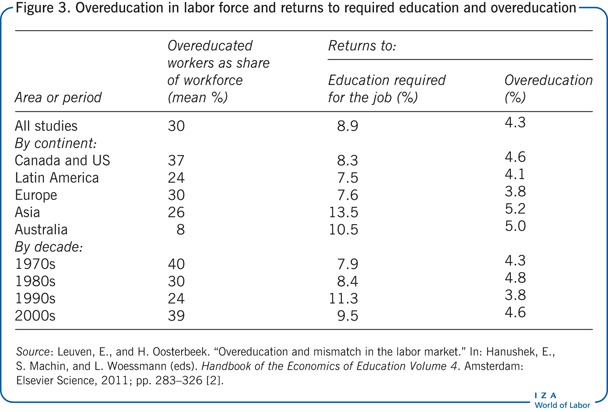Elevator pitch
As the number of secondary school graduates rises, many developing countries expand the supply of public and private universities or face pressure to do so. However, several factors point to the need for caution, including weak job markets, low-quality university programs, and job–education mismatches. More university graduates in this context could exacerbate unemployment, underemployment, and overeducation of professionals. Whether governments should regulate the quantity or quality of university programs, however, depends on the specific combination of factors in each country.

Key findings
Pros
Regulating the quantity and quality of university graduates might reduce the probability of overeducation and professional underemployment.
Preventing the unbridled growth of public and private universities could avoid waste of resources in low-return investments arising from information asymmetry about university quality.
Regulating university quantity and quality would provide students with information on university quality and employability of graduates needed for better decisions on long-term investments in human capital.
Cons
Limiting growth in the number of university students may constrain improvements in the human capital stock of the economy.
Limiting growth in the number of university students would reduce the economic and productivity growth potential of the economy.
Intervening in the higher education market could impede the upward economic and social mobility of younger members of the population.
Regulations affecting the quantity and quality of university graduates might be difficult to enforce in countries with weak institutional capacity.
Author's main message
A rapid increase in university graduates in developing countries might exacerbate overeducation and underemployment of professionals. Some regulation would seem necessary to reduce large differences in university quality and widespread information asymmetries. Options range from providing information on employability (by institution and career) to mandating quality assurance and licensing. Career quotas, moratoriums on expansion, and other extreme forms of quantitative control are inadvisable given rapid changes in market demand and weak enforcement capacity in most developing countries.
Motivation
There are opposing views about the correct level of investment in higher education. On one side, supporters of more investment claim that human capital shortages are reducing countries’ comparative advantage in fields that depend on skilled labor. On the opposite side, opponents argue that investment in higher education is too high and the labor market returns to education are too low.
In response to the mounting demand for a college education from rising numbers of high school graduates, many developing countries have deregulated the university market. They have allowed private profit and nonprofit institutions to enter the market, massively increasing the supply of higher education, without determining whether this supply boom is resulting in high underemployment among professionals. A more cautious approach, taken by countries with stronger regulatory and enforcement institutions, has been to set minimum standards for licensing new private and public universities and to promote quality assurance through mandatory or voluntary accreditation mechanisms.
There is more agreement on the efficiency and equity benefits of providing reliable information on performance in the labor market by graduates of specific institutions and in specific fields. Such information can reduce the information asymmetries facing students who are making long-term career decisions related to higher education. Also important, though not discussed here, is the role of government in financing higher education.
Discussion of pros and cons
Gross enrollment ratios in higher education (university and other postsecondary programs) in developing countries more than doubled from 1999 to 2013, rising from around 12% to 26% (Figure 1). This doubling trend was seen in almost all developing country regions, including sub-Saharan Africa, though it started from a considerably lower base there. Only Caucasus and Central Asia and North Africa experienced more moderate growth rates. Taking a longer perspective back to the 1970s shows an acceleration in this process of skill-upgrading in developing countries during the last two decades compared with the first two (see the Illustration).

Two main structural reasons underlie this boom in higher education in developing countries. First, rates of high school enrollment and completion have been increasing in all regions, expanding the pool of potential higher education students. Second, the rise in income per capita in recent decades also predicts greater demand for higher education.
The potential consequences of a rising supply of college graduates
In theory, if growth in demand for skilled workers does not keep pace with the rising supply of college graduates, relative wages decline (what economists call a falling college premium or falling return to education), and unemployment, underemployment, and overeducation (working at a job that requires less education than one has) rise. Job–education mismatches may also arise if a large share of university graduates fall short of the quality standards and skills demanded by the labor market.
Falling returns to higher education? The debate in the US
In the US, the debate on overeducation emerged in the 1970s, with a study warning of falling returns to higher education following a steep rise in college completion rates [1]. Other studies tempered this initial pessimism by including additional years of observations. Using more evidence, studies found that returns to college education increased between the 1970s and the 2000s, presumably because the information revolution and skill-bias technological change led to increased demand for qualified workers [2].
More formally, a canonical model of relative wages was developed to interpret several recent trends in the college premium. The principal results show that the gap between the skilled and unskilled labor force increased linearly from the 1980s to the 2000s [3].
Today, the debate continues. One side claims that there is a shortage of college graduates. From this point of view, supply has failed to keep pace with growing demand, resulting in an estimated gap of nearly 20 million workers [4]. Consequently, returns to college education and income inequality have grown dramatically. This position is based on three main arguments. An increase in college graduates amplifies technological innovation and economic growth. As the premium for a college education rises, supply fails to keep pace with the increasing demand for skilled workers. And having a larger share of college graduates increases equity within society.
The other side argues that there is an oversupply of college graduates. One study puts the oversupply at 48%, with five million graduates ending up underemployed [5]. Increasing evidence for developing countries shows that a high average return to a college education can coexist with a fairly sizable share of professional underemployment, because of the wide difference in education quality, information asymmetries, and the employability of graduates.
Lower or higher returns to college in developing countries?
Making an important contribution to the empirical literature on returns to education, a global study found a U-shaped pattern of returns to education for the 1980s, averaging at 15–18% for primary education, 11–13% for secondary education, and 12–20% for college education [6]. An update of these findings for developing country regions in the 2000s finds that the average private return to an additional year of education is 12% for primary school, 5.9% for secondary school, and 15% for higher education (Figure 2). The return to an extra year of college is as high as 21% in Africa, 17.3% in South Asia, and 15.9% in Latin America. A comparison of trends for eight developing countries in Asia and Latin America finds that all of them experienced an increase in the college wage premium between the 1970s and the early 1990s [7]. However, more recent evidence for some Latin American countries shows a reduction in the college premium in the 2000s [8].

The empirical literature on overeducation
Another strand of the literature emerged from an empirical modification of the standard earnings function, developed in the 1960s by Jacob Mincer to explain workers’ wages based on education and work experience. The modification allows for calculating different returns for the required years of education in a specific job and the return to years of overeducation or undereducation [9]. This specification can also be used to test the standard Becker-Schultz human capital theory, in which an additional year of education increases productivity and earnings regardless of the specific job, or an alternative Thurow theory of fixed productivity given by the job, which results in monetary compensation only for the years of education required to perform the job (returns to overeducation and undereducation should not be significantly different from zero).
Estimates of the number of overeducated workers around the world are based on identification of the number of years of education required for the jobs they fill. Some surveys ask workers directly about their perceptions of the years of education needed for their job, others rely on analyses of competencies required for specific jobs, and still others define needed years of education within the survey as the mean or median number of actual years of education of the workers in a specific job. Any significant number of years in excess (more than one standard deviation difference) of those deemed necessary in one of these three ways is considered overeducation.
While the general concept of overeducation includes overeducated workers at all levels of education, it typically refers to higher education and thus concerns mainly underemployment of professionals. Estimates of the extent of overeducation around the world by decade indicate that the overschooled fraction of the workforce declined considerably between the 1970s and 1990s but that the trend reversed during the 2000s (Figure 3) [2]. Current levels of overeducation are almost identical to those registered some 40 years ago.
One possible explanation for this phenomenon, related to the situation in the US at the beginning of 1990s, is that overeducation is a transitory stage in some occupations that require additional learning (human capital formation) on the job. Studies found that overeducated workers were younger and had less on-the-job training than other workers [10]. The studies argued that overeducation could be understood as a trade-off between schooling and other components of human capital. However, longitudinal data often show the persistence of overeducation in several types of workers over the long term.
Many studies have estimated specific returns to overeducation for developed and developing countries. A recent assessment finds that the average return to required education is around 8%, whereas the average return to overeducation is only about half that (see Figure 3) [2]. These results support a slightly modified version of the human-capital story, with some return to overeducation though less than the return to the required years of education for a specific job. Nevertheless, the review concludes that these results cannot be considered causal because of unresolved econometric restrictions—measurement errors and bias stemming from the inadvertent omission of some important variables. In most of the literature surveyed, these two issues have not been satisfactorily addressed.
The literature posits several explanations for the lower returns to overeducation, including compensation for an insufficient stock of other components of human capital, such as training and ability investment in job credentials for new labor force participants, and excess supply for scarce professional positions. Surprisingly, two other possible explanations for lower returns to overeducation and underemployment in developing countries are not mentioned in this literature: differences in the quality of education and job–education mismatches. A more recent study for Peru, which did take the quality of education into account, concludes that education quality is the most important determinant of the probability of being overeducated.
A recent study using Italian data also finds that overeducation is strongly determined by education quality. Having a degree from a high-quality research-oriented university significantly reduces the probability of being overeducated. This finding is consistent with a theoretical model in which low-ability individuals use education to signal an ability trait that they do not have. They enroll in low-quality universities in order to send a distorted signal of their productivity [11].
Impact of higher education on economic growth
There are two ways to explain the effect of knowledge on growth. One is based on the traditional theory of the relationship between productivity and income. The second explanation is based on endogenous growth theory (economic growth springs from such endogenous factors as investment in human capital, innovation, and knowledge), which posits that a highly-skilled workforce is necessary to achieve higher levels of development through the adaptation and transfer of technology, as well as higher incomes. This makes it important to review the evidence on the impact of higher education on economic growth, particularly in developing countries.
The most recent literature on the relationship between development and higher education focuses on Africa, Central America, and Southeast Asia. The results are ambiguous. For low-income countries, statistical evidence shows that increases in primary and secondary education have had a greater impact on growth than increases in higher education. However, studies that take time dynamics into account show positive effects for all education levels, but greater effects for higher education.
Studies for sub-Saharan Africa find that investment in higher education can produce significant public and private benefits in countries with enrollment rates below 10%. Most of the benefits come from narrowing technological gaps through greater technological diffusion, which leads to faster economic growth and poverty alleviation.
The effect of overeducation on economic growth is a much less studied phenomenon. Several labor market models have been developed to establish the theoretical foundations for the impact of overeducation on production. One model postulates that underemployment—whether based on years of education or skills—may have adverse effects on productivity because workers with more education than required for the job may engage in counterproductive behavior in the workplace [12].
An opposing view, for a wide range of EU countries, sees overqualified workers as more productive than their less qualified counterparts. A French study reaches a more nuanced conclusion on overeducation, finding a positive premium on wages in the short term but a potentially adverse effect on GDP growth in the long term.
Purely from a growth accounting perspective, overeducation could be interpreted as human capital accumulation that cannot be absorbed in “optimal” job matches, resulting in underemployment, which is a less efficient use of that capacity. Therefore, overeducation would generate less productivity growth than in the case of better education–job match. A study of US Bell companies in the telecoms industry shows that firms that do not fully use the educational skills of their workers suffer a loss in output. Indeed, an additional year of overeducation was related to an 8.35% drop in firm output.
Extent of university regulation
While there are no cross-country data on regulation of higher education, it seems safe to assume that private institutions are less regulated than public institutions. An overwhelming majority of developing and developed countries with available data show sizable increases in the share of higher education supplied by private institutions. In some Latin American countries, private enrollment surpasses public enrollment in higher education. Private enrollment accounts for 84% of total enrollment in Chile, 72% in Brazil, and 62% in Peru.
Regulation in Latin America
For countries with available data on regulation of university supply, there is evidence of recent supply restrictions in Latin America. Ecuador, for instance, instituted annual assessments of higher education institutions. It closed 14 universities after they failed to implement a quality accreditation program required by law. Arguing that there was an excessive unregulated supply of universities, Peru in 2012 instituted a moratorium on opening new universities until a new quality-supervising regulating agency could be put in place.
In 2001, the Education Ministry of Colombia ordered one university to close, following seven previous sanctions, due to the poor quality of the services it offered. A similar incident occurred in Chile, which closed one university indefinitely after findings of corruption and the results of a survey identified it as the worst higher education institution in terms of its graduates’ skills.
Regulation in the US
The US is considered to have one of the most open business environments for ease of opening and closing a business and high levels of economic and political freedom. Yet for universities, federal regulation requires that any institution that plans to offer a university education receive official approval from every state in which it would offer programs.
Most states have a university licensing authority that assesses the institutional mission and examines the plans, infrastructure, and teaching staff of university programs. For example, the New York State Education Department enforces a Protocol for Opening a College within its jurisdiction and requires authorization from the Board of Regents before an institution may confer degrees. The main objective is to determine whether an institution meets quality standards and whether there is adequate demand and need for the proposed programs. Texas, which takes a less interventionist approach, also has a detailed mandatory procedure to apply for a license through its Workforce Commission.
At the federal level, the US Department of Education’s Office of Post-Secondary Education oversees the accreditation of institutions of higher education through its recognition of national and regional accrediting agencies. While accreditation is not mandatory for all institutions, the US government helps ensure acceptable levels of quality through its leading role in maintaining public databases with information on the quality of education at the institutional and program level. For instance, someone planning to go to college in Texas can find a list of colleges that are no longer authorized to confer degrees as well as a list of accredited university programs.
Evidence on the effectiveness of university regulation
Evidence is scarce on the impact of quantitative and qualitative regulations both within and across countries. In the case of Ecuador, the closure of 14 universities seems to have served as a strong warning to other universities and planned institutions of higher education of the government’s intent to oversee quality. Since the government began to conduct annual assessments of higher education institutions, the number of professors with a post-graduate degree has increased substantially, and teaching conditions and research facilities have improved noticeably.
A study by the oldest accrediting agency in the US, the New England Association of Schools and Colleges, presented comprehensive qualitative evidence supporting the effectiveness of accreditation in offering public assurances of the quality of institutions of higher education. In Hungary, seven years after it instituted an accreditation system, the higher education system was consolidated and standardized.
However, quality assurance and accreditation, as currently practiced in many countries, are not necessarily adequate. Most indicators of quality assurance stress inputs (such as infrastructure and teaching credentials) and intermediate outputs (such as graduation rates). Measurement of value-added or impact (such as employability indexes of graduates and academic production of faculty), innovation, and responsiveness to the changing demands of the economy are not usually taken into account.
Limitations and gaps
The empirical evidence is still very limited on whether the rapid increase in the number of university graduates in developing countries will lead to falling returns to college education as a result of professional underemployment and overeducation. There has been very little research and impact evaluation in this crucial area for economic development. More internationally comparable data are needed on institutional and administrative practices, an effort that should be sponsored by multilateral organizations such as the UN Educational, Scientific, and Cultural Organization and the World Bank. Likewise, more national studies and cross-country analyses are needed to assess the effectiveness of various regulatory methods for ensuring adequate quality in higher education institutions, especially as university supply expands in developing countries.
Data on the earnings and employability of graduates by career and institution are also mostly lacking. Publicizing such data could help students make more informed long-term career decisions about schools and programs without the need for complicated university accreditation infrastructure. The challenge, however, is how to get such data for developing countries, most of which have extensive informal sectors whose activities are largely unrecorded. Large household surveys with oversampling for professionals in the labor market could complement any income records obtained by tax agencies.
Summary and policy advice
The rapid rise in the number of university graduates in developing countries could lead to falling returns to college education, overeducation, and professional underemployment. College quality and the extent of job–education mismatches vary considerably. The information asymmetries inherent in an experience good such as a university education (a product or service whose quality cannot be fully determined before it is purchased and consumed [13]) and the long and irreversible period of investment suggest the need for some kind of government intervention.
Regulatory options cover a wide range, from providing information about graduates’ employability by institution and program and other quality measures, to mandatory quality assurance mechanisms, licensing, and quantity controls. Extreme forms of quantitative control such as quotas by career are inadvisable, given the rapid change in market demand and the dynamics of job creation and destruction. Moreover, such controls are almost impossible to enforce in developing countries, because of weak institutional capacities. Rather than trying to control the supply of higher education, policies should focus on the collection and dissemination of information on employability by career and institution, and on quality assurance measures. Effective implementation of these options requires the active participation of education, labor, and tax authorities, as well as the commitment of business associations.
Acknowledgments
The author thanks three anonymous referees and the IZA World of Labor editors for many helpful suggestions on earlier drafts. The author also thanks Nelson Oviedo for superb research support and Juan F. Castro, Pablo Lavado, and Liz Reisberg for many helpful comments and suggestions. Institutional support by Universidad del Pacífico is gratefully acknowledged.
Competing interests
The IZA World of Labor project is committed to the IZA Guiding Principles of Research Integrity. The author declares to have observed these principles.
© Gustavo Yamada
Overeducation and underemployment
Overeducation is defined as working at a job that requires less education than the worker has accumulated. Required education is determined in various ways, through surveys of worker perceptions of the years of education needed for their job, analyses of competencies required for specific jobs, and mean or median number of actual years of education of workers in a specific job.
Underemployment is defined by the International Labour Organization as the underutilization of the productive capacity of the employed population. Underemployed workers tend to work fewer hours than they would like, earn less income, or use their occupational skills incompletely. Thus, overeducation is one possible source of underemployment.
